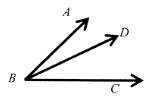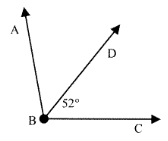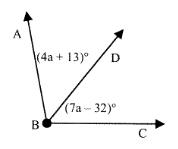ANGLE BISECTOR AND SUPPLEMENTARY ANGLES
Subscribe to our ▶️ YouTube channel 🔴 for the latest videos, updates, and tips.
Angle bisector :
An angle bisector is defined as a ray, segment, or line that divides a given angle into two angles of equal measures. The word bisector or bisection means dividing into equal parts.

∠AOC and ∠COB are equal.
Supplementary angles :
Two angles are supplementary angles if the sum of their measures is equal to 180 degrees.
Problem 1 :
Which angles are named in the pictures below.

Solution:
When an angle measures between 0° and 90°. It is called an acute angle.
The acute angles are ∠HOP and ∠POE.
Problem 2 :
If m ∡ABD = 22° and m ∡DBC = 53°, then find m ∡ABC.

Solution:
∡ABC = ∡ABD + ∡DBC
∡ABC = 22° + 53°
∡ABC = 75°
Problem 3 :
Find m ∠1 and m ∠2

Solution:
∠1 = 122° (vertically opposite angles)
122° + ∠2 = 180° (linear pair)
∠2 = 180 - 122
∠2 = 58°
Problem 4 :
Find m∠ABC if BD is an angle bisector.

Solution:
m∠ABC = 2 × ∠DBC
= 2 × 52°
m∠ABC = 104°
Problem 5 :
Find m ∠ABC if BD is an angle bisector.

Solution:
∠ABD = ∠DBC
4a + 13 = 7a - 32
7a - 4a = 32 + 13
3a = 45
a = 15
m ∠ABC = 2 × ((4 × 15) + 3)°
= 2 × 73°
m ∠ABC = 146°
Problem 6 :
If m∠1 = (2x + 45)° and m∠2 = (5x - 45)°, find m∠1.

Solution:
m∠1 = m∠2 (vertically opposite angles)
2x + 45 = 5x - 45
5x - 2x = 45 + 45
3x = 90
x = 30
m∠1 = (2x + 45)°
= (60 + 45)°
m∠1 = 105°
Problem 7 :
What is the supplement of a 56° angle?
Solution:
Supplement of the angle = 180° - x
= 180° - 56°
= 124°
Problem 8 :
If ∡A and ∡B are supplementary, and m ∡A = (7x + 16)°, and m ∡B = (9x - 12)°. Write the equation you would use to find x.
Solution:
The sum of the measures of two supplementary angles is 180°.
m ∡A + m ∡B = 180°
7x + 16 + 9x - 12 = 180°
16x + 4 = 180°
16x = 176
x = 11
Subscribe to our ▶️ YouTube channel 🔴 for the latest videos, updates, and tips.
Recent Articles
-
Finding Range of Values Inequality Problems
May 21, 24 08:51 PM
Finding Range of Values Inequality Problems -
Solving Two Step Inequality Word Problems
May 21, 24 08:51 AM
Solving Two Step Inequality Word Problems -
Exponential Function Context and Data Modeling
May 20, 24 10:45 PM
Exponential Function Context and Data Modeling